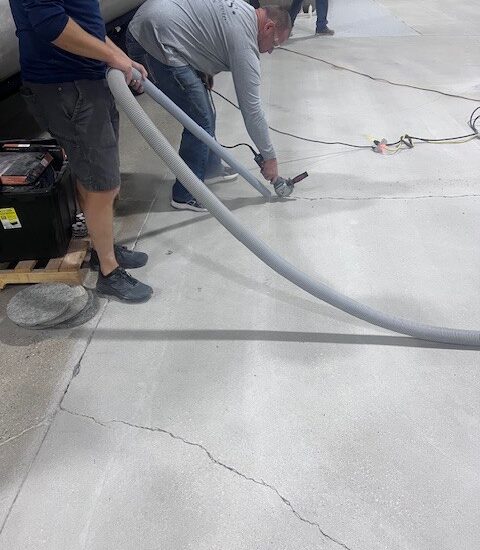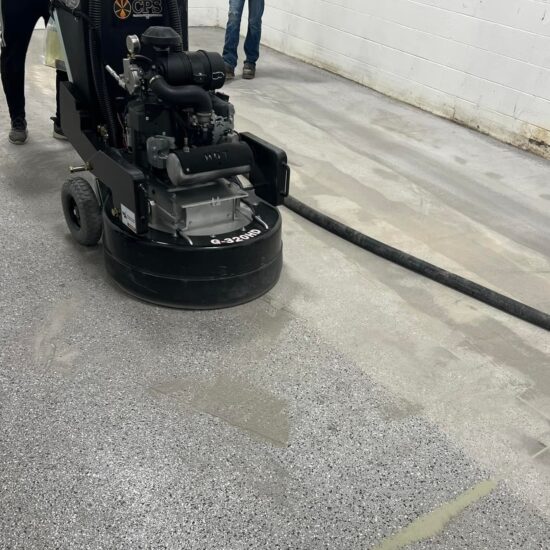Can You Repair or Recoat Existing Concrete Floor Coatings? A Professional Guide for Damaged Surfaces
As concrete coating professionals, we’re often asked if it’s possible to repair or recoat an existing surface instead of doing a full replacement.
The good news is that yes, it is possible in most cases.
Recoating or repairing is not only achievable but often a more effective and efficient choice. However, the success of this solution depends on a few key factors like the condition of the current coating, the type of damage present, and the materials used in the repair process.
When these elements are carefully considered, a long-lasting and effective result is very possible without the need for a complete overhaul.
When Can a Concrete Surface Be Recoated?
Before recommending a repair or recoating solution, you need to assess the condition of the existing coating and substrate of your client’s space or area.
A thorough evaluation will help determine whether a recoat is viable or if full removal and replacement are necessary. Consider the following:
- Coating adhesion: If the existing concrete floor coatings are still well-bonded to the substrate with minimal signs of delamination, a recoat may be a simple and effective solution. And, if large sections are peeling or flaking, removal may be required.
- Extent of damage: Small cracks, chips, and surface wear can typically be addressed by patching and recoating with premium concrete floor supply. More severe structural damage, such as deep cracks or substrate erosion, may necessitate additional concrete repairs before recoating.
- Environmental exposure: Surfaces that have been exposed to moisture, chemicals, or extreme temperatures may have compromised coatings, requiring careful assessment before proceeding with a recoat.
By carefully evaluating these factors, you can determine the best approach for achieving long-lasting results.
Essential Surface Preparation for Long-Lasting Concrete Floor Coatings
Surface preparation is the foundation for your successful recoating job. Even the best coatings will fail if they are applied to an unprepared surface.
The following steps ensure optimal adhesion and performance:
- Surface profiling: Grinding or shot blasting removes contaminants, roughens the surface, and enhances mechanical adhesion for the new coating.
Here, our team conducted a repair and surface preparation, by grinding and polishing the concrete floor before the recoating.


Our team in concrete repair, polishing, and grinding
- Crack and chip repair: Use high-quality patching compounds compatible with the new coating system to address imperfections before application.
- Cleaning and degreasing: Oils, grease, and other contaminants must be completely removed using appropriate cleaning solutions to prevent adhesion failure.
- Moisture testing: Excessive moisture in the concrete can lead to coating delamination. Testing ensures the surface is dry enough for proper adhesion.
Pro Tip: Cutting corners on preparation often results in premature coating failure, leading to costly rework. Investing in thorough prep pays off in long-term durability.
Selecting the Right Coating for Recoating Applications
Not all coatings are suitable for recoating existing surfaces. Choosing the right concrete floor coatings depends on the condition of the substrate and the intended use of the coated surface. Some of the best options include:
- Polyaspartic coatings: Known for their superior adhesion, fast cure times, and high durability, polyaspartic coatings are an excellent choice for recoating projects.
- Polyurea coatings: These coatings offer extreme flexibility and resistance to chemicals and abrasions, making them ideal for industrial applications.
- Epoxy coatings: While epoxy remains a popular choice, it requires additional surface priming and may take longer to cure than polyaspartic or polyurea systems.
According to the American Concrete Institute (ACI), polyaspartic and polyurea coatings outperform traditional epoxy in environments subject to high moisture or rapid temperature changes.
Client Success: How Recoating Transformed Concrete Floor
In a concrete grinding and polishing training, a concrete floor needed a durable floor recoating for a client in Wisconsin. Some part of the garage floor had worn down, but a full replacement would mean extensive downtime. After moisture testing and thorough grinding, we polished and sealed with Microguard, cutting the timeline in half while ensuring a seamless, hygienic finish.
A team member says: “What a great start to the week! What a difference in the floors!”
Participants also had the opportunity to see two distinct techniques in action:
- The light grey side of the floor demonstrated a polish and guard system, showcasing a high-gloss, durable finish.
- The darker side of the floor was a grind and seal with MicroGuard, illustrating a different approach to sealing and protecting concrete surfaces
This hands-on experience reinforces the importance of surface preparation, proper coating selection, and expert application techniques for achieving long-lasting results.
Our successful concrete repair and recoating
When Full Coating Removal Is Necessary
While recoating is often the preferred solution, there are cases where full removal of the existing concrete floor coatings is unavoidable.
If the current coating of your client exhibits widespread failure—such as bubbling, peeling, or extreme wear—starting fresh is often the best course of action.
Complete removal allows you to perform proper surface restoration and ensures that the new coating bonds effectively, preventing further issues.
FAQs on Concrete Floor Coatings Repair and Recoating
1. Can I apply a new coating over an old one without removing it?
Yes, but only if the existing coating is still well-adhered and free of major defects like peeling or bubbling. It is important to know the advantages of concrete polishing and grinding to ensure strong adhesion.
2. How do I know if the current coating is too damaged for recoating?
If the coating has widespread peeling, deep cracks in the substrate, or signs of chemical degradation, a complete removal is recommended before applying a new coating.
3. What are the best concrete floor coatings for recoating projects?
Polyaspartic and polyurea coatings are excellent choices due to their strong adhesion properties, durability, and fast cure times. Epoxy coatings can also work but may require additional priming.
4. How should I repair cracks or chips before recoating?
Use a high-quality, compatible patching compound to fill cracks and chips, ensuring a smooth surface before applying the new coating. Grinding or shot blasting may also be necessary to prepare your client’s area.
5. Can moisture in the concrete affect the recoating process?
Yes, excessive moisture can lead to adhesion failure and bubbling. Moisture testing should be conducted before recoating to prevent potential issues.
Final Thoughts: A Strategic Approach to Recoating Concrete Surfaces
Recoating and repairing concrete floors can extend surface life, minimize downtime, and reduce costs when done correctly.
- Thorough assessment ensures the right approach
- Proper surface preparation prevents premature failures
- Choosing the right coating maximizes durability
Ready to transform your concrete floors? Call at 833-663-4255 to learn more about coating systems and how they can enhance your next repair or recoating project.

